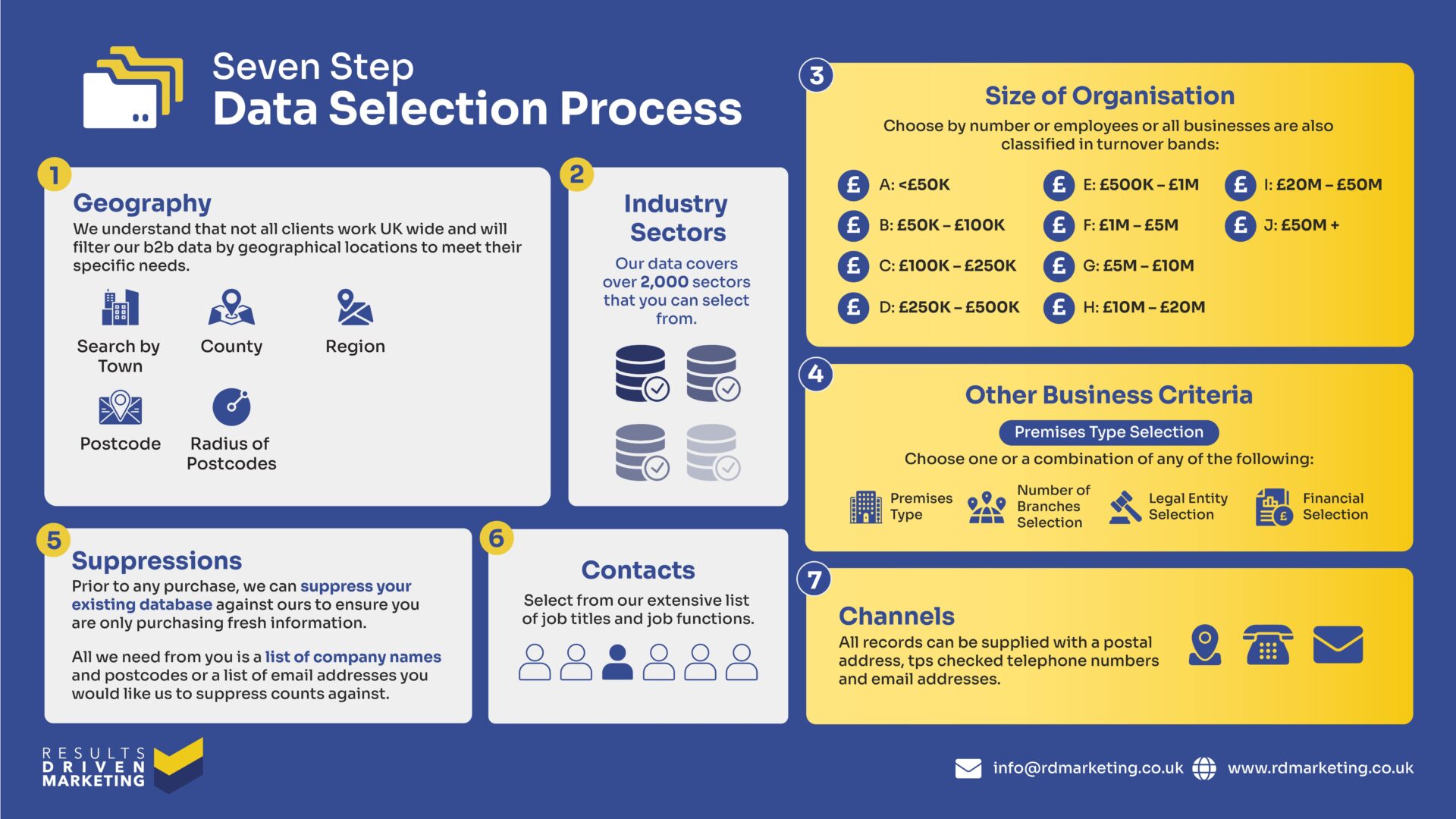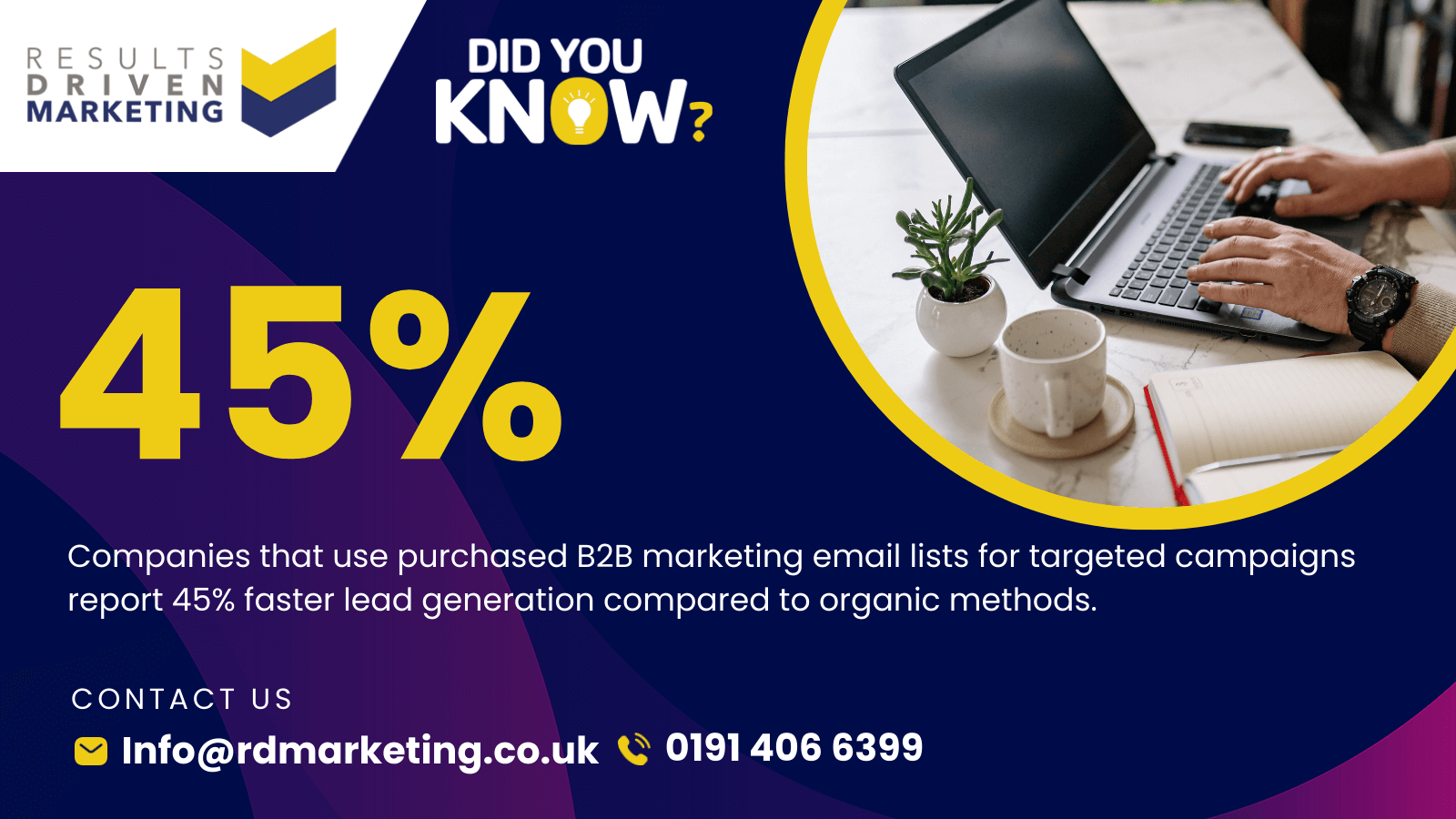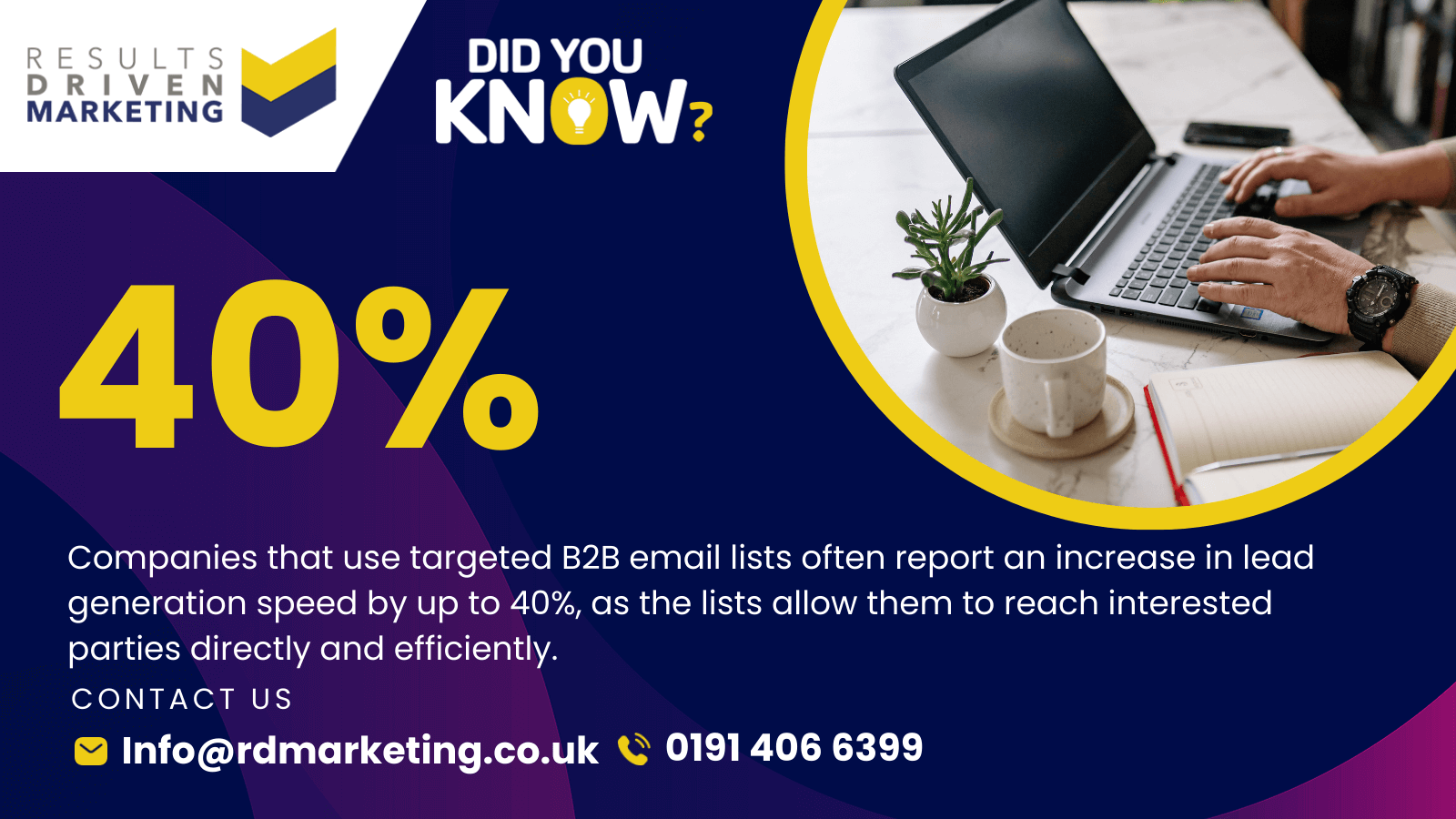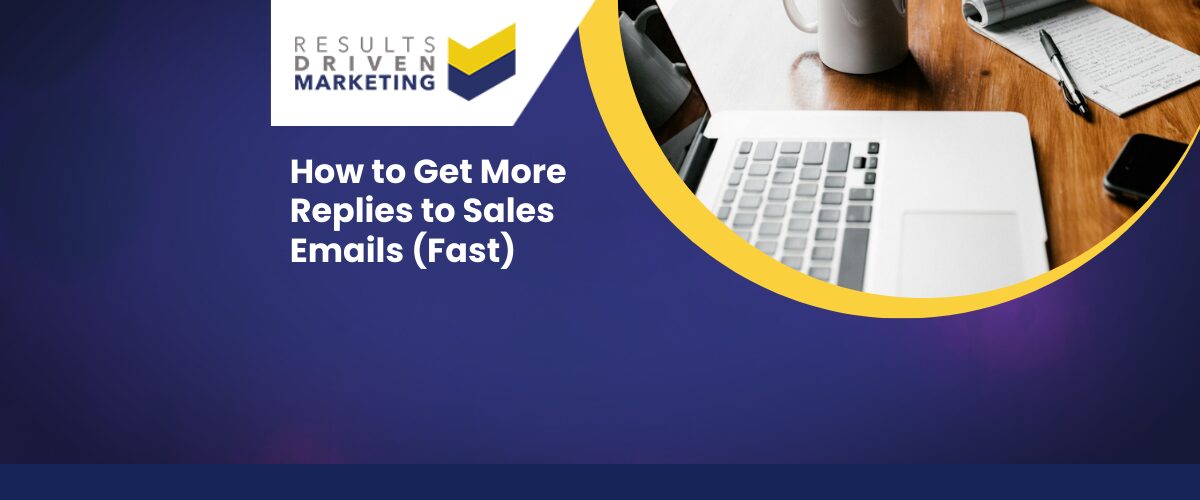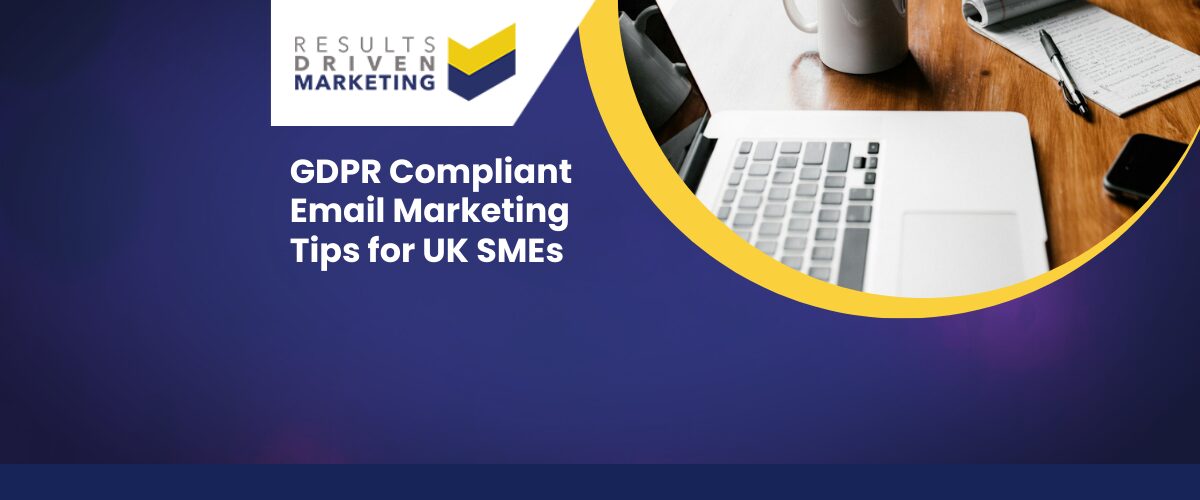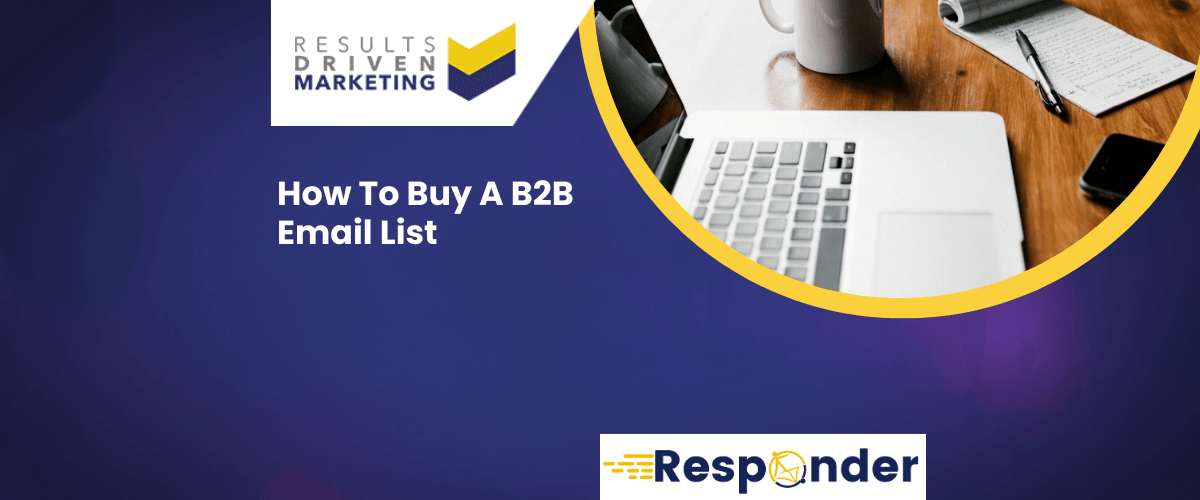
How To Buy A B2B Email List
When exploring how to buy a B2B email list, it’s essential to grasp exactly what these lists entail. A B2B email list is a curated collection of email addresses from individuals in key decision-making roles within various businesses.
Unlike B2C lists, which target individual consumers, B2B email lists are designed to facilitate direct business-to-business interactions and transactions.
Definition of a B2B Email List: A B2B email list comprises contact details specifically selected to reach influential figures in the business world who have the authority to make purchasing decisions. For building a targeted email list, RD Marketing’s B2B Data services offer a comprehensive solution tailored to meet diverse industry needs.
Differences Between B2B and B2C Email Lists: The primary difference lies in their target audiences. B2B email lists are intended for business representatives, requiring a professional tone and often detailed industry-specific information. For more insights, consider RD Marketing’s Telemarketing Data and Email Address List Data.
Importance in B2B Marketing: Email lists are crucial in B2B marketing for fostering direct communications with industry leaders and enabling personalised marketing strategies. Utilising a well-segmented International Email List can expand your global business reach effectively.
Additionally, ensuring data accuracy through RD Marketing’s Data Cleansing Services enhances the effectiveness of your marketing campaigns.
By understanding and utilising B2B email lists effectively, businesses can significantly improve their marketing outreach and achieve substantial growth. For optimising your email campaigns, RD Marketing also offers Email Marketing Management Services, ensuring maximum engagement and efficiency.
Table of contents:
Why Businesses Buy B2B Email Lists
When it comes to modern marketing strategies, businesses often need a way to fast-track their lead generation efforts and connect with the right audience. That’s where purchasing a B2B marketing email list becomes a game-changer. Here’s why businesses increasingly rely on this approach:
Accelerated Lead Generation Compared to Organic Efforts
Building an email list organically—whether through website signups, events, or social media—takes time. While this method has its merits, it’s not always the fastest solution for businesses that need to act quickly.
- A B2B marketing email list lets you skip the waiting game by providing instant access to a pool of pre-qualified prospects.
- Instead of spending months collecting contacts, you can focus on crafting campaigns that resonate with your audience right away.
For businesses that prioritise speed and efficiency, our B2B Data services offer a seamless way to access targeted and verified data, helping you accelerate your outreach without compromising on quality.
Access to Highly Targeted Audiences
Not all audiences are created equal, and targeting the wrong people can lead to wasted resources and low ROI. A B2B marketing email list solves this problem by giving you access to specific audiences based on:
- Industry: Focus on niches like healthcare, technology, or retail.
- Geography: Reach businesses in particular regions, cities, or countries.
- Job Roles: Connect with decision-makers such as CEOs, Marketing Managers, or HR professionals.
Customisation is key here. By tailoring your email list to your exact needs, you can ensure that your messages resonate with the recipients. For example, if you’re running a telemarketing campaign, our Telemarketing Data services can help you engage the right contacts effectively.
Support for Multi-Channel Marketing Campaigns
A B2B marketing email list doesn’t just support email marketing—it’s the backbone of multi-channel campaigns. With a robust database, you can create cohesive strategies that span:
- Email Campaigns: Deliver personalised messages straight to inboxes.
- Direct Mail: Combine email efforts with our Direct Mail Data for a powerful offline touchpoint.
- Telemarketing: Use the same list to make targeted calls to prospects.
This multi-pronged approach increases your chances of engaging leads through the channel they prefer, ultimately boosting your conversion rates.
Time and Cost Efficiency for Scaling Quickly
Scaling a business often requires making the most of your resources. With a B2B marketing email list, you can:
- Save countless hours spent on manual lead generation.
- Reduce costs by targeting only those contacts most likely to convert.
- Streamline your campaigns with precise segmentation and personalisation.
If your business operates across borders, our International Email List services allow you to expand your reach globally without the hassle of gathering data from scratch.
Key Factors to Consider Before Purchasing a B2B Marketing Email List
Buying a B2B marketing email list can be a great way to turbocharge your marketing efforts, but success hinges on choosing the right list.
There are a few critical factors you need to evaluate before making your purchase to ensure that the data aligns with your goals and delivers the results you’re looking for.
Relevance: Does the List Match Your Target Market?
When it comes to marketing, relevance is everything. An effective B2B marketing email list should closely match the profile of your ideal customers. Ask yourself:
- Does the list include businesses in the industries you’re targeting?
- Are the contacts based in the geographic regions you want to reach?
- Does it contain decision-makers or influencers who can make purchasing decisions?
For instance, if you’re targeting a niche market, such as manufacturing or healthcare, investing in highly specific data can make all the difference. Our B2B Data services allow you to access lists tailored to your audience, ensuring every email you send has maximum impact.
Compliance: Is the List Legally Safe to Use?
Here’s what to check:
- GDPR Compliance: Are the contacts in the database properly consented if you’re targeting audiences in Europe?
- Opt-In Practices: Is the data sourced ethically and responsibly?
At RD Marketing, we ensure all our lists meet the highest compliance standards. Additionally, our CTPS Checker can help you verify that your campaigns don’t inadvertently target numbers on the Corporate Telephone Preference Service (CTPS) registry.
Data Quality: Is the Information Accurate and Up-to-Date?
The quality of your B2B marketing email list directly impacts your campaign’s success. Outdated or inaccurate data can lead to low open rates, high bounce rates, and even blacklisting by email service providers.
When evaluating data quality, consider:
- Accuracy: Are the email addresses verified to reduce bounce rates?
- Up-to-Date Information: Is the data refreshed regularly to reflect changes in job roles or company details?
- Additional Insights: Does the list include supplemental details like company size or revenue, which can help you refine your targeting?
Our Email Address List Data service provides verified and reliable lists, while our Data Cleansing Services can help you clean and update any existing lists to ensure they’re in top shape.
Customisability: Can the List Be Tailored to Your Needs?
One size doesn’t fit all when it comes to marketing. A good B2B marketing email list should be customisable so that it fits the unique needs of your campaign. Look for providers who offer filters like:
- Industry Segmentation: Focus on key sectors such as finance, technology, or retail.
- Geographic Targeting: Narrow down your list to specific regions or countries.
- Job Roles: Target decision-makers like CEOs, HR Managers, or Procurement Heads.
At RD Marketing, we specialise in providing fully customisable lists. Whether you need an International Email List to expand your global reach or Consumer Data for broader campaigns, we can deliver data that meets your exact specifications.
B2B Email Marketing Lists: How to Choose, Prepare, and Use Them Effectively
When teams search for B2B email marketing lists, the goal isn’t just to acquire contacts—it’s to turn that data into conversations and revenue. Use this practical checklist to go from selection to first campaign with confidence.
1) Selection Checklist (Fitting the List to Your Offer)
-
Audience–Offer Match: Map your core offer to sectors, job roles, and company sizes that feel the pain you solve.
-
Granularity: Prioritise fields you’ll actually segment on (industry, headcount bands, region, seniority).
-
Recency & Refresh Cadence: Ask how often the data is refreshed and what the refresh window is (e.g., rolling monthly updates).
-
Custom Cuts: Confirm you can request tailored cuts (e.g., “UK manufacturers, 10–50 staff, Ops/Procurement decision-makers”).
Tip: RD Marketing’s B2B Data and International Email List services provide flexible selections so you only pay for the audiences you’ll actually target.
2) Compliance Foundations (Keep It Clean and Defensible)
-
Lawful Basis: For UK/EU B2B outreach, ensure you have a valid lawful basis (often legitimate interests in appropriate contexts).
-
Clear Identity & Easy Opt-Outs: Every email must state who you are and provide a one-click unsubscribe.
-
Telephone Considerations: If you’ll call any records, run the CTPS Checker to respect Corporate TPS rules.
This is not legal advice—always confirm your approach with your compliance lead or counsel.
3) Deliverability Setup (Protect Your Sender Reputation)
-
Warm Domain & IP: If you’re using a new or dedicated sending domain, warm gradually before volume ramps.
-
Authentication: Set up SPF, DKIM, and DMARC for your sending domain.
-
List Hygiene on Day 0: De-duplicate, standardise fields, remove obvious traps/format errors. RD Marketing’s Data Cleansing Services help here.
4) Segmentation Blueprint (Make Messages Feel Personal at Scale)
Segment your B2B email marketing lists by:
-
Industry & Sub-sector: Tailor pain points (e.g., compliance for finance vs. throughput for manufacturing).
-
Role & Seniority: Decision-maker vs. influencer messaging (strategy vs. hands-on gains).
-
Firmographics: Employee bands, turnover, multi-site vs. single-site.
-
Engagement: Opens, clicks, replies, and website behaviours for progressive profiling.
Then align content:
-
Hook line: A problem statement each segment recognises instantly.
-
Proof: One relevant stat, case note, or mini-outcome per segment.
-
CTA: One simple, low-friction next step (book a call, download, price guide).
5) Campaign Cadence (From First Touch to Qualified Conversation)
-
Touch 1: Value-forward intro (insight or resource) + soft CTA.
-
Touch 2–3: Objection handling, micro-case, or short demo clip; vary the CTA.
-
Touch 4+: Social proof or ROI mini-calculator; offer an alternative path (e.g., direct mail or a short call).
Pair email with Direct Mail Data or Telemarketing Data to create a light, multi-channel lift that raises reply rates.
6) Ongoing Hygiene & Enrichment (Keep Performance Rising)
-
Routine Cleans: Remove hard bounces and chronic non-engagers; fix malformed addresses.
-
Field Enrichment: Add missing job titles, locations, or technologies to power finer segments.
-
Feedback Loops: Track replies, objections, and reasons for “not now” to refine selections and copy.
RD Marketing’s Data Cleansing and Data Enrichment Services keep lists campaign-ready over time.
7) Measurement That Matters (Prove ROI, Not Just Opens)
-
Leading Indicators: Deliverability rate, bounce rate, first-open rate.
-
Engagement: Click-through, positive replies, meeting books.
-
Commercial: Pipeline created, win rate, revenue per 1,000 contacts.
-
Cost Lens: Compare cost per meeting and cost per opportunity to organic and paid channels.
Common Pitfalls to Avoid When Buying a B2B Marketing Email List
Purchasing a B2B marketing email list can be a game-changer for your campaigns—but only if you do it right. Making the wrong choices can lead to wasted resources, legal troubles, and disappointing results. To ensure your investment delivers value, it’s crucial to avoid these common pitfalls:
Purchasing from Unverified or Non-Reputable Providers
One of the biggest mistakes businesses make is buying a B2B marketing email list from unverified or low-quality providers. If the provider cannot guarantee accurate, up-to-date, and verified data, you risk paying for irrelevant or invalid contacts.
What to watch out for:
- Providers offering lists at suspiciously low prices.
- Lack of transparency about how the data was sourced.
- No option to request a sample of the list before purchase.
Choosing a trusted provider like RD Marketing ensures you’ll receive reliable data that meets your campaign goals. Whether you’re targeting specific industries with our B2B Data services or running telemarketing campaigns with Telemarketing Data, we’ve got you covered.
Key compliance checks to prioritise:
- Ensure all data is collected ethically and includes proper opt-in permissions.
- Verify that the list complies with local and international data protection laws.
- Use tools like our CTPS Checker to avoid contacting restricted numbers.
By partnering with RD Marketing, you can rest assured that all our email lists meet the highest compliance standards, protecting your business from unnecessary risks.
Overlooking the Importance of Regular Data Cleansing
Even the best B2B marketing email list can become outdated over time. Contact details change, roles shift, and companies restructure, which means data that isn’t cleaned regularly can quickly lose its value.
The consequences of ignoring data cleansing include:
- High bounce rates that harm your sender reputation.
- Irrelevant contacts wasting your marketing efforts.
- Missed opportunities to engage with active prospects.
Our Data Cleansing Services can help you maintain a clean, accurate database, ensuring your campaigns consistently reach the right audience.
Failing to Plan How the List Will Be Used in Campaigns
A B2B marketing email list is only as effective as the strategy behind it. Many businesses make the mistake of purchasing a list without a clear plan for segmentation, messaging, or campaign execution.
Steps to avoid this pitfall:
Define your goals—lead generation, brand awareness, or conversions.
Segment your list by criteria such as industry, location, or job role.
Personalise your outreach to resonate with your audience.
At RD Marketing, we provide not only premium email lists but also solutions to enhance your campaigns, like Email Marketing Management Services to streamline your outreach and maximise results.
How to Maximise ROI From Your B2B Marketing Email List
A B2B marketing email list is a powerful asset, but how you use it determines the success of your campaigns. To truly get the most out of your email list, you need to focus on strategies that enhance engagement, improve targeting, and ensure long-term data quality.
Let’s dive into some proven approaches that will help you achieve a higher return on investment (ROI).
Personalisation Strategies for Email Campaigns
Gone are the days when generic email blasts yielded results. Today, personalisation is non-negotiable. By tailoring your emails to each recipient, you can boost engagement and conversions significantly. Here’s how you can personalise effectively:
- Dynamic Content: Use recipient data to create email copy that resonates, such as addressing them by name or referencing their company.
- Behavior-Based Triggers: Send follow-up emails based on user actions, like downloads or event registrations.
- Relevant Offers: Ensure your offers match the recipient’s job role, industry, or pain points.
For instance, with RD Marketing’s Email Marketing Management Services, you can automate these personalisation techniques, making your campaigns more effective and time-efficient.
Using Segmentation for Targeted Messaging
Segmentation is key to making your B2B marketing email list work smarter, not harder. By categorising your contacts into specific groups, you can craft highly relevant messages that resonate with each segment.
- Segmentation Criteria:
- Industry or sector.
- Geographic location.
- Job roles and seniority.
- Purchase history or behavioral data.
- Benefits of Segmentation:
- Higher open rates due to relevant subject lines.
- Improved click-through rates as the content addresses specific needs.
- Reduced unsubscribes since recipients feel understood.
For example, RD Marketing’s International Email List lets you target businesses worldwide while ensuring your messaging aligns with regional preferences.
Tracking Campaign Metrics
Measuring the success of your email campaigns is just as important as running them. Metrics provide insights into what’s working and what needs improvement. Focus on these key metrics:
- Open Rates: Gauge how compelling your subject lines are.
- Click-Through Rates (CTR): Understand how engaging your email content is.
- Conversions: Measure the ultimate goal—whether it’s downloading a brochure, filling out a form, or making a purchase.
- Bounce Rates: Keep an eye on undelivered emails, which could indicate outdated or inaccurate data.
RD Marketing’s CTPS Checker ensures your list is compliant and reduces the risk of deliverability issues, helping you maintain high campaign performance.
Importance of Regular Data Cleansing and Enrichment
A B2B marketing email list isn’t a one-time investment—it requires ongoing maintenance to remain effective. Over time, data can become outdated as people change roles, companies, or email addresses. Here’s what you can do:
- Data Cleansing: Remove duplicates, update incorrect entries, and eliminate inactive contacts. This keeps your list lean and impactful.
- Data Enrichment: Enhance your existing data with additional insights like job titles, company sizes, or buying preferences. This helps you refine your targeting.
RD Marketing offers professional Data Cleansing Services and Data Enrichment Services to ensure your email lists are always in top shape.
Marketing to B2B Email Lists
Overcoming the Challenges of Marketing Products and Services to B2B Emails in the UK
Introduction
Email marketing is a powerful tool in the B2B marketer’s arsenal, offering a direct line of communication to potential clients.
However, marketing products and services to B2B emails in the UK comes with its own set of unique challenges. Here’s a closer look at these challenges and how to overcome them.
Understanding the Market
One of the primary challenges in marketing to B2B emails in the UK is understanding the market itself. Unlike consumer markets, which are often driven by personal preferences and emotions, B2B markets are driven by the need for efficiency and return on investment.
This means that B2B marketers must not only understand their customers’ businesses but also the broader industry trends and dynamics that affect them.
Creating Relevant Content
B2B buyers are typically looking for information that can help them solve a problem or meet a need. This means that your email content needs to be relevant, informative, and value-driven.
Creating this type of content can be a challenge, but it’s crucial for engaging your audience and driving conversions.
Building Trust
Trust is a crucial factor in B2B marketing. B2B buyers need to know that they can rely on your company to deliver quality products or services, on time and at a fair price. Building this trust can be a challenge, especially in the impersonal world of email marketing.
However, it can be achieved through consistent performance, clear communication, and a commitment to customer service.
Navigating Spam Filters
One of the technical challenges of marketing to B2B emails in the UK is navigating spam filters. If your emails are consistently marked as spam, they may not reach your intended recipients.
To avoid this, it’s important to follow best practices for email marketing, such as using a reputable email service provider, avoiding spam trigger words in your subject lines, and ensuring your recipients have opted in to receive your emails.
Conclusion
Marketing products and services to B2B emails in the UK is not without its challenges. However, with a deep understanding of the market, a commitment to creating relevant content, a focus on building trust, and a strategy for navigating spam filters, these challenges can be overcome.
By doing so, businesses can tap into the lucrative potential of the B2B email market in the UK.
Crafting Compelling Value Propositions for B2B Email Lists
Introduction
A value proposition is a clear statement that explains how your product solves customers’ problems, delivers specific benefits, and tells the customer why they should buy from you and not from the competition.
For businesses promoting products and services to B2B email lists, crafting a compelling value proposition is crucial to stand out in a competitive market. Here’s how to do it.
Understanding Your Customer
The first step in crafting a compelling value proposition is understanding your customer. In the context of B2B email lists, this means understanding the unique needs, challenges, and goals of the businesses on your list. What problems are they trying to solve? What benefits are they looking for? The more you understand about your customer, the better you can tailor your value proposition to their needs.
Highlighting Unique Benefits
Once you understand your customer, the next step is to highlight the unique benefits of your product or service. What makes your offering different from the competition? How does it solve the customer’s problems in a way that other products or services don’t? Be specific and concrete in describing these benefits.
For example, if your product saves time on business processes, quantify this benefit in terms of hours or days saved.
Communicating Credibility
B2B buyers, like all businesses, want to work with suppliers they can trust. Therefore, your value proposition should communicate your credibility.
This could involve highlighting your experience in the industry, showcasing testimonials from satisfied customers, or providing evidence of the effectiveness of your product or service.
Making It Clear and Concise
A compelling value proposition is clear and concise. It should be easy for the businesses on your B2B email lists to understand what you’re offering, why it’s beneficial, and why they should choose you over the competition. Avoid jargon and keep your language simple and straightforward.
Testing and Refining
Finally, remember that crafting a compelling value proposition is an ongoing process. Test your value proposition with a small segment of your B2B email lists, gather feedback, and refine it as needed. What works for one business may not work for another, so be prepared to adapt your value proposition to different segments of your list.
Conclusion
Crafting a compelling value proposition is crucial for businesses promoting products and services to B2B email lists. By understanding your customer, highlighting unique benefits, communicating credibility, making your value proposition clear and concise, and testing and refining as needed, you can create a value proposition that resonates with B2B buyers and helps your business stand out.
Email Marketing to B2B Email Lists
The Benefits of Email Marketing for Businesses Looking to Buy Business Emails
Introduction
Email marketing is a powerful tool in the B2B marketer’s arsenal, offering a direct line of communication to potential clients. For businesses looking to buy business emails, understanding the benefits of email marketing can help maximise the return on their investment. Here’s a closer look at these benefits.
Direct Communication
One of the primary benefits of email marketing is that it allows for direct communication with potential clients. Unlike other forms of marketing, which rely on broadcasting messages to a wide audience, email marketing allows you to send targeted messages directly to the inboxes of the businesses on your B2B email lists.
Highly Targeted
When you buy business emails, you have the opportunity to segment your list based on various criteria, such as industry, company size, or job role. This allows you to tailor your emails to the specific needs and interests of each segment, increasing the relevance of your emails and, in turn, your response rates.
Cost-Effective
Email marketing is one of the most cost-effective marketing strategies. The costs associated with sending emails are relatively low, and when done correctly, email marketing can deliver a strong return on investment. This makes it an attractive option for businesses looking to maximise the value of their B2B email lists.
Measurable
Another benefit of email marketing is that it’s highly measurable. Most email marketing platforms provide detailed analytics, including open rates, click-through rates, and conversion rates. This allows you to track the success of your campaigns, test different strategies, and refine your approach based on what works best.
Builds Relationships
Finally, email marketing is an excellent tool for building relationships with potential clients. By providing valuable content in your emails, you can position your business as a trusted advisor, making potential clients more likely to choose you when they’re ready to buy.
Conclusion
For businesses looking to buy business emails, email marketing offers numerous benefits. From direct communication and targeted messaging to cost-effectiveness, measurability, and relationship building, email marketing can help businesses maximise the value of their B2B email lists and drive their success.
Email Marketing Best Practices for Businesses Using a B2B Contact List
Introduction
Email marketing is a powerful tool in the B2B marketer’s arsenal, offering a direct line of communication to potential clients. However, to make the most of your B2B contact list, it’s crucial to follow email marketing best practices. Here’s a closer look at these best practices and how to implement them.
Understanding Your Audience
The first step in any successful email marketing campaign is understanding your audience. This means understanding the unique needs, challenges, and goals of the businesses on your B2B contact list. The more you understand about your audience, the better you can tailor your emails to their needs.
Segmenting Your List
Once you understand your audience, the next step is to segment your B2B contact list. This involves dividing your list into smaller, more targeted groups based on specific criteria, such as industry, company size, or job role. Segmenting your list allows you to tailor your emails to the specific needs and interests of each group, increasing the relevance of your emails and, in turn, your response rates.
Creating Valuable Content
The content of your emails is crucial. To engage your audience and drive conversions, your emails should provide value to the businesses on your B2B contact list. This could involve sharing useful tips, providing industry insights, or offering exclusive deals.
Personalising Your Emails
Personalisation can significantly increase email engagement rates. This could involve including the recipient’s name in the email, tailoring the content to their specific needs or interests, or sending emails based on specific triggers, such as a recent purchase or website visit.
Testing and Refining
Finally, remember that email marketing is an ongoing process. Test different strategies, track the results, and refine your approach based on what works best. What works for one segment of your B2B contact list may not work for another, so be prepared to adapt your approach as needed.
Conclusion
By understanding your audience, segmenting your B2B contact list, creating valuable content, personalising your emails, and testing and refining your approach, you can make your email marketing campaigns more effective and drive better results for your business. These best practices can help you make the most of your B2B contact list and maximise your return on investment.
A/B Split Testing Email Marketing Campaigns for Businesses Using a B2B Email Database
Introduction
Email marketing is a powerful tool for reaching potential B2B customers. However, to ensure your campaigns are as effective as possible, it’s crucial to use A/B split testing. This involves testing two versions of an email to see which one performs better. Here’s a step-by-step guide on how to do it with your B2B email database.
Understanding A/B Split Testing
A/B split testing, also known as split testing or bucket testing, is a method of comparing two versions of an email to determine which one performs better. It’s a way to test changes to your emails against the current design and determine which one produces better results.
Step 1: Choose What to Test
The first step in A/B testing is deciding what element of your email you want to test. This could be anything from the subject line, the email content, the call-to-action, or even the sending time. Remember to test only one element at a time to ensure that you can accurately determine what caused any changes in performance.
Step 2: Create Two Versions of Your Email
Once you’ve decided what to test, create two versions of your email: one with the current version (the control) and one with the change you want to test (the variant). For example, if you’re testing the subject line, you might create one email with your current subject line and one with a new subject line.
Step 3: Split Your B2B Email Database
Next, split your B2B email database into two groups. One group will receive the control email, and the other group will receive the variant. It’s important to ensure that these groups are as similar as possible to ensure accurate results.
Step 4: Send Your Emails and Collect Data
Send out your emails and collect data on how each version performs. Most email marketing platforms provide detailed analytics, including open rates, click-through rates, and conversion rates.
Step 5: Analyse the Results
Once you’ve collected your data, analyse the results to see which version of your email performed better. If the variant performed better, consider making the tested change permanent in your future emails.
Conclusion
A/B split testing is a powerful tool for improving your email marketing campaigns. By testing different elements of your emails, you can continually refine your approach and make your campaigns more effective. This can help you make the most of your B2B email database and drive better results for your business.
Measuring the Results of Email Marketing Campaigns: A Guide for Businesses Looking to Buy a B2B Email Database
Email marketing is a powerful tool in the B2B marketer’s arsenal, offering a direct line of communication to potential clients. However, to ensure your email marketing efforts are effective, it’s crucial to measure the results of your campaigns. This guide will walk you through the process of measuring the results of email marketing campaigns when marketing to B2B email lists.
Understanding Email Marketing Metrics
The first step in measuring the results of your email marketing campaigns is understanding the key metrics. Here are a few of the most important ones:
Open Rate: This is the percentage of recipients who open your email. A high open rate generally indicates that your subject line is effective at grabbing the recipient’s attention.
Click-Through Rate (CTR): This is the percentage of recipients who click on a link in your email. A high CTR indicates that your email content is engaging and relevant to the recipient.
Conversion Rate: This is the percentage of recipients who take a desired action after clicking on a link in your email, such as making a purchase or filling out a form. A high conversion rate indicates that your email is effective at driving action.
Bounce Rate: This is the percentage of emails that were not delivered to the recipient’s inbox. A high bounce rate could indicate problems with your email list, such as outdated or incorrect email addresses.
Unsubscribe Rate: This is the percentage of recipients who unsubscribe from your email list after receiving your email. A high unsubscribe rate could indicate that your emails are not meeting the expectations of your recipients.
Using an Email Marketing Platform
Most email marketing platforms provide tools to help you track these metrics. When you buy a B2B email database, it’s important to choose a platform that provides detailed analytics. This will allow you to track the success of your campaigns, test different strategies, and refine your approach based on what works best.
Conclusion
Measuring the results of your email marketing campaigns is crucial for businesses looking to buy a B2B email database. By understanding key email marketing metrics and using an email marketing platform that provides detailed analytics, you can ensure your email marketing efforts are delivering a strong return on investment. This will help you make the most of your B2B email database and drive your business success.
Crafting Effective Email Marketing Call to Actions for B2B Sales: A Guide to Buy B2B Email Database
In the realm of B2B marketing, the power of a well-crafted email cannot be overstated. It’s a direct line to your potential clients, a chance to showcase your products or services, and an opportunity to persuade them to take action.
But how do you ensure that your call to action (CTA) is compelling enough to convert? This part of the article will guide you on how to craft effective email marketing call to actions when selling products and services to B2B email lists. We will also discuss how to optimise your strategy to buy B2B email database.
Understand Your Audience
Before you can craft an effective CTA, you need to understand your audience. Who are they? What are their needs and pain points? How can your product or service solve their problems? The more you know about your audience, the better you can tailor your CTA to resonate with them. This is also a crucial step when you decide to buy B2B email database. Ensure that the database you purchase aligns with your target audience.
Craft a Clear and Concise CTA
Your CTA should be clear and concise. It should tell your audience exactly what you want them to do and why they should do it. Use action-oriented language and keep it short and sweet. For example, instead of saying “Click here for more information,” you could say “Download our guide now to improve your business efficiency.”
Create a Sense of Urgency
Creating a sense of urgency can encourage your audience to take action immediately. This can be done by using time-sensitive language or offering limited-time discounts or bonuses. For instance, “Buy now and get 20% off your first order. Offer ends soon!”
Make Your CTA Stand Out
Your CTA should be the most prominent part of your email. Use design elements like colour, size, and placement to make it stand out. It should be easy for your audience to find and click on your CTA.
Test and Optimise Your CTA
Finally, don’t forget to test and optimise your CTA. Use A/B testing to see which version of your CTA gets the most clicks. This can help you understand what works and what doesn’t, allowing you to continuously improve your CTA and increase your conversion rates.
Conclusion
Crafting an effective email marketing call to action is an art. It requires a deep understanding of your audience, a clear and concise message, a sense of urgency, and continuous testing and optimisation. And when you decide to buy B2B email database, ensure that it aligns with your target audience and your marketing goals. With these strategies, you can create compelling CTAs that convert and drive your B2B sales to new heights.
Mastering the Art of Email Marketing Subject Lines for B2B Sales: A Comprehensive Guide to Building Your B2B Contact List
In the world of B2B marketing, the first impression often comes in the form of an email subject line. It’s the first thing your potential clients see, and it can make or break whether they open your email or send it straight to the trash.
Crafting compelling email marketing subject lines is an essential skill when selling products and services to businesses. This part of the article will guide you on how to create engaging subject lines and how to optimise your strategy to build a robust B2B contact list.
Understand Your Audience
The first step in crafting compelling subject lines is understanding your audience. What are their needs, pain points, and interests? How can your product or service address these? The more you know about your audience, the better you can tailor your subject lines to resonate with them. This understanding is also crucial when building your B2B contact list. Ensure that the contacts you add align with your target audience.
Keep It Short and Sweet
Your subject line should be short, sweet, and to the point. Most email platforms truncate subject lines after about 60 characters, so aim to convey your message within this limit. A concise subject line is easier to read and understand, increasing the chances of your email being opened.
Use Action-Oriented Language
Using action-oriented language in your subject line can help to create a sense of urgency and encourage your audience to open your email. Phrases like “Take advantage of,” “Don’t miss out on,” or “Get started with” can be effective.
Personalise Your Subject Lines
Personalisation can significantly increase your email open rates. This could be as simple as including the recipient’s name in the subject line, or as complex as tailoring the subject line based on their industry, role, or previous interactions with your company.
Test and Optimise Your Subject Lines
Finally, always test and optimise your subject lines. Use A/B testing to compare the performance of different subject lines and use this data to continuously improve. This approach can also be applied when building your B2B contact list. Regularly review and update your list to ensure it remains relevant and effective.
Conclusion
Crafting compelling email marketing subject lines is both an art and a science. It requires a deep understanding of your audience, a knack for concise and engaging language, a touch of personalisation, and a commitment to continuous testing and optimisation. And when it comes to building your B2B contact list, ensure that it aligns with your target audience and your marketing goals. With these strategies, you can create subject lines that grab attention and drive your B2B sales to new heights.
Decoding Email Marketing ROI for B2B Campaigns: A Guide to Buy Business Emails
Email marketing remains a powerful tool in the B2B marketer’s arsenal, offering direct access to potential clients and a platform to showcase products or services.
However, understanding the return on investment (ROI) of these campaigns is crucial to gauge their effectiveness and justify the decision to buy business emails.
This part of the article will guide you on how to calculate email marketing ROI when marketing to businesses and how to optimise your strategy when you decide to buy business emails.
Understand the Basics of ROI
ROI is a measure of the profitability of an investment. In the context of email marketing, it’s the ratio of net profit to the cost of the campaign. The basic formula for calculating ROI is:
ROI = (Net Profit / Cost of Investment) x 100
Calculate the Cost of Investment
When calculating the cost of your email marketing campaign, consider all associated expenses. This includes the cost to buy business emails, the cost of your email marketing platform, the cost of creating content, and any other related expenses.
Determine Your Net Profit
Net profit is the total revenue generated from the campaign minus the cost of the campaign. To calculate this, you’ll need to track the revenue generated from your email marketing campaign. This could be direct sales from a product or service, or indirect revenue from lead generation and conversions.
Calculate Your ROI
Once you have your net profit and cost of investment, you can calculate your ROI. For example, if your net profit is $10,000 and your cost of investment is $2,000, your ROI would be:
ROI = ($10,000 / $2,000) x 100 = 500%
This means that for every dollar you invested in the campaign, you made a return of $5.
Use Your ROI to Inform Future Campaigns
Understanding your ROI can help you make informed decisions about future email marketing campaigns. It can guide you on whether to buy business emails, how much to invest in content creation, and which types of campaigns are most effective.
Conclusion
Calculating email marketing ROI is a crucial step in understanding the effectiveness of your B2B marketing campaigns. It provides a clear picture of your campaign’s profitability and can guide your future marketing decisions.
When you decide to buy business emails, ensure that your investment aligns with your marketing goals and budget. With a clear understanding of ROI, you can make informed decisions that drive your B2B sales and grow your business.
Segmenting B2B Email Lists for Maximum Response Rates: A Comprehensive Guide for Businesses
In the world of B2B marketing, email remains a powerful tool for reaching potential clients and promoting your products or services. However, to achieve maximum response rates, it’s crucial to segment your email marketing lists effectively.
This part of the article will guide you on how to segment B2B email lists for maximum response rates when selling products and services to businesses.
Understand the Importance of Segmentation
Segmentation is the process of dividing your email list into smaller, more targeted groups based on specific criteria. This allows you to tailor your emails to the specific needs and interests of each group, resulting in more relevant and engaging content. This relevance can significantly increase your response rates and overall effectiveness of your B2B email lists.
Identify Your Segmentation Criteria
The first step in segmenting your B2B email lists is to identify your segmentation criteria. These could include industry, company size, job role, past purchase behaviour, or engagement with previous emails. The more specific your segments, the more personalised and effective your emails can be.
Create Tailored Content for Each Segment
Once you’ve segmented your B2B email lists, it’s time to create tailored content for each segment. This could include personalised product recommendations, industry-specific tips and advice, or targeted promotions. Remember, the goal is to provide value to each segment and encourage them to engage with your emails.
Monitor and Adjust Your Segments Over Time
Segmentation is not a one-time task. It’s important to monitor your segments over time and adjust them as necessary. This could be due to changes in your audience, your products or services, or your overall marketing strategy. Regularly reviewing and updating your segments can help ensure your emails remain relevant and effective.
Use Segmentation to Optimise Your B2B Email Lists
Finally, use segmentation to optimise your B2B email lists. This could involve removing inactive subscribers, targeting high-value segments with special offers, or testing different segmentation strategies to see what works best. The more optimised your B2B email lists, the higher your response rates will be.
Conclusion
Segmenting your B2B email lists is a powerful strategy for increasing response rates and maximising the effectiveness of your email marketing campaigns.
By understanding your audience, identifying your segmentation criteria, creating tailored content, and continuously monitoring and adjusting your segments, you can create highly targeted and engaging emails that drive results.
So, when you’re ready to take your B2B email marketing to the next level, remember the power of segmentation.
Integrating Email Marketing with Other Channels for B2B Success: A Guide to Building a B2B Email List in the UK
In the dynamic landscape of B2B marketing, integrating your email marketing campaigns with other marketing channels can significantly enhance your reach and impact. This multi-channel approach ensures a consistent message across all platforms, boosting brand recognition and engagement.
This part of the article will guide you on how to integrate email marketing campaigns with other marketing channels when selling products and services to businesses, with a focus on building a B2B email list in the UK.
Understand the Power of Integration
Integrating your email marketing campaigns with other marketing channels allows you to create a cohesive and consistent brand message. It enables you to reach your audience wherever they are, increasing the chances of engagement and conversion.
This is particularly important when building a B2B email list in the UK, where businesses often engage with multiple marketing channels.
Identify Your Key Marketing Channels
The first step in integration is identifying your key marketing channels. These could include social media, content marketing, SEO, PPC advertising, and more.
Consider where your target audience spends their time and which channels they are most likely to engage with. This will guide your integration strategy and help you build a more effective B2B email list in the UK.
Create a Consistent Brand Message
Once you’ve identified your key marketing channels, it’s time to create a consistent brand message. This means ensuring that your emails, social media posts, blog articles, and other marketing materials all convey the same core message. This consistency can increase brand recognition and trust, boosting your overall marketing effectiveness.
Leverage Cross-Promotion
Cross-promotion is a powerful tool for integrating your email marketing campaigns with other marketing channels. This could involve promoting your email newsletter on social media, including links to your blog articles in your emails, or using PPC advertising to drive sign-ups for your email list. Cross-promotion can help you reach a larger audience and build a more robust B2B email list in the UK.
Monitor and Adjust Your Integration Strategy
Finally, it’s important to monitor and adjust your integration strategy over time. Use analytics to track the performance of your different marketing channels and see how they interact with each other. This can help you identify what’s working, what’s not, and where you need to make adjustments.
Conclusion
Purchasing a high-quality B2B marketing email list is a powerful step toward driving meaningful business growth. From accelerating lead generation to boosting ROI, the benefits of using a targeted and customisable email list are undeniable. It allows businesses to connect with their ideal audience, create personalised campaigns, and scale their marketing efforts quickly and efficiently.
However, not all email lists are created equal. The success of your investment depends heavily on working with a reputable provider that prioritises compliance, data accuracy, and relevance. A trusted provider like RD Marketing ensures you’ll receive premium data that meets your unique business needs, whether you’re targeting a specific industry, role, or geographic location.
Who are we?
Thinking about “how do I buy data“?
Providing b2b database solutions is our passion.
Offering a consultancy service prior to purchase, our advisors always aim to supply a database that meets your specific marketing needs, exactly.
We also supply email marketing solutions with our email marketing platform and email automation software.
Results Driven Marketing have the best data of email lists for your networking solutions as well as direct mailing lists & telemarketing data in telemarketing lists
We provide data cleansing and data enrichment services to make sure you get the best data quality.
We provide email marketing lists and an international email list for your business needs.
At RDM We provide b2c data as we have connections with the best b2c data brokers.
A good quality b2b database is the heartbeat of any direct marketing campaign…
It makes sense to ensure you have access to the best!
Call us today on 0191 406 6399 to discuss your specific needs.
Results Driven Marketing
0191 406 6399


